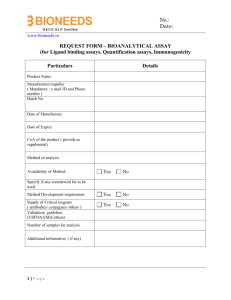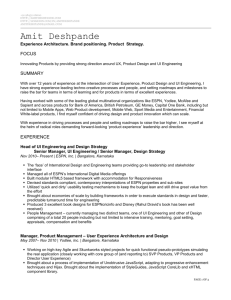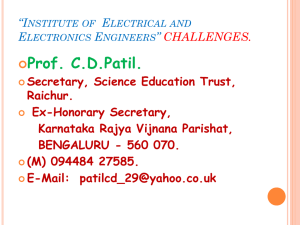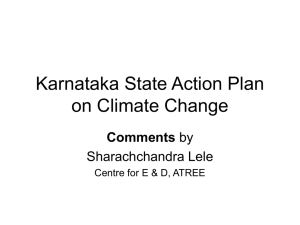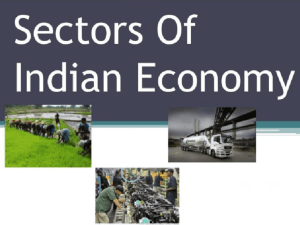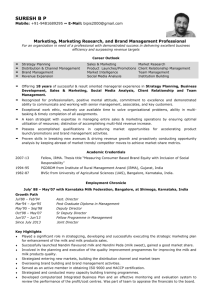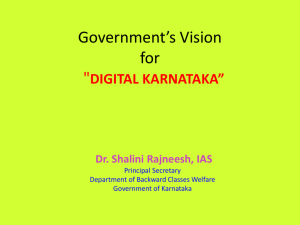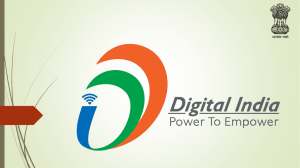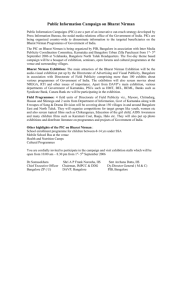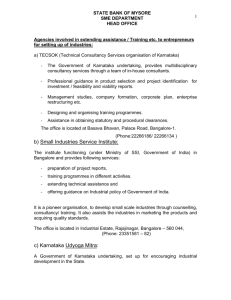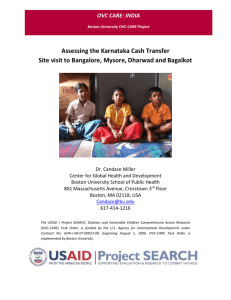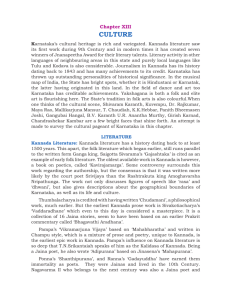Executive Summary-Water Seminar
advertisement
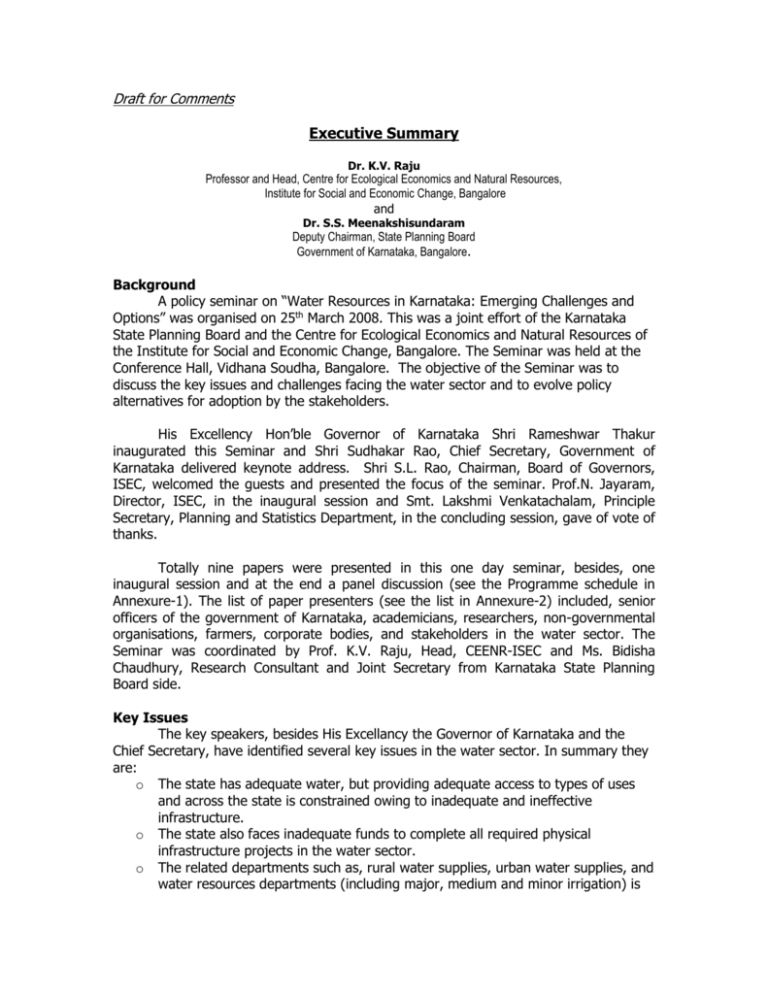
Draft for Comments Executive Summary Dr. K.V. Raju Professor and Head, Centre for Ecological Economics and Natural Resources, Institute for Social and Economic Change, Bangalore and Dr. S.S. Meenakshisundaram Deputy Chairman, State Planning Board Government of Karnataka, Bangalore. Background A policy seminar on “Water Resources in Karnataka: Emerging Challenges and Options” was organised on 25th March 2008. This was a joint effort of the Karnataka State Planning Board and the Centre for Ecological Economics and Natural Resources of the Institute for Social and Economic Change, Bangalore. The Seminar was held at the Conference Hall, Vidhana Soudha, Bangalore. The objective of the Seminar was to discuss the key issues and challenges facing the water sector and to evolve policy alternatives for adoption by the stakeholders. His Excellency Hon’ble Governor of Karnataka Shri Rameshwar Thakur inaugurated this Seminar and Shri Sudhakar Rao, Chief Secretary, Government of Karnataka delivered keynote address. Shri S.L. Rao, Chairman, Board of Governors, ISEC, welcomed the guests and presented the focus of the seminar. Prof.N. Jayaram, Director, ISEC, in the inaugural session and Smt. Lakshmi Venkatachalam, Principle Secretary, Planning and Statistics Department, in the concluding session, gave of vote of thanks. Totally nine papers were presented in this one day seminar, besides, one inaugural session and at the end a panel discussion (see the Programme schedule in Annexure-1). The list of paper presenters (see the list in Annexure-2) included, senior officers of the government of Karnataka, academicians, researchers, non-governmental organisations, farmers, corporate bodies, and stakeholders in the water sector. The Seminar was coordinated by Prof. K.V. Raju, Head, CEENR-ISEC and Ms. Bidisha Chaudhury, Research Consultant and Joint Secretary from Karnataka State Planning Board side. Key Issues The key speakers, besides His Excellancy the Governor of Karnataka and the Chief Secretary, have identified several key issues in the water sector. In summary they are: o The state has adequate water, but providing adequate access to types of uses and across the state is constrained owing to inadequate and ineffective infrastructure. o The state also faces inadequate funds to complete all required physical infrastructure projects in the water sector. o The related departments such as, rural water supplies, urban water supplies, and water resources departments (including major, medium and minor irrigation) is o o o o o affected by lack of manpower, effective organisational systems, and inadequate capacity building. Water resource use in the state is suffering from low use efficiency levels. Across the state and across the types of uses, the sector is burdened with inadequate distribution infrastructure. There is inadequate convergence of various schemes, running simultaneously in the state. The state is seriously threatened from over-exploitation of groundwater use in several parts of the state and laced with lack of groundwater recharge measures. Inadequate efforts is unable to bring in robust and productive participation from water users at different levels. Strategic Options One of the major objective of this seminar is to evolve possible strategic options to enable the water sector to perform better in a more efficient way and it should be better governed. Thereby, all speakers consistently stressed on various aspects in this regard both as short-term and long-term steps. o o o o o o o o o o Needs massive investments. Promote massive investments through publicprivate-panchayat mode. Quicker estimates by several speakers indicated that the sector needs Rs 70,000 crores in the next 10 years. Explore various options to design, execute, operation and maintain the systems o BOOT – Build, own, operate and transfer o ROOT – Rehabilitate, own, operate and transfer and any other The water sector need to unbundle its functions into: a) water procurement, b) operation and maintenance, c) distribution & revenue collection, d) pricing The state needs to improve its performance measurement criteria at all levels of the water sector. Across the related departments, the water sector needs to strengthen skill up gradation on a regular basis and Rejuvenate tanks on sub-basin mode with stakeholders Need paradigm shift in groundwater management – licencing, local mgmt (eg), pump efficiency The state need to stress on harnessing solar energy in river lifts, rural water supplies and in urban water supplies. The water sector quickly needs to redesign its operation and maintenance policy. Set up Independent Water Resources Regulation Authority with following key responsibilities. o Water allocations across sectors –domestic, industrial, agriculture, environmental. o Design and implement efficient conveying mechanisms from source to consumer level – take overall view of the entire state. o Water auditing at project level (all projects) o Enhance water use efficiency levels. o Rationalise water tariff across sectors o Performance measurement criteria at all levels o Convergence of all related schemes/programmes o Setting up institutional mechanisms and facilitating it. o For effective resource management, the state needs River Basin Organisations. Also to manage competitive demands both in the short and long-term periods. o It is necessary to develop vision documents, keeping in view of emerging demands of rural and urban supplies, at river basin and sub-basin level. o Need to focus on Integrated Water Resources Management, in tune with the global management practices. o Promote rain water harvesting for primary use both in urban and rural areas -40%. o Simplify procedures and data base management. o Capacity building of officials at all level, WUAs, federations o Establish coordination cells with agriculture, revenue, environment and fisheries departments. o Policy and legal framework to support all the above o Water Resources Department should play strong role as infrastructure creator and a facilitator. o Top-priority to utilization of already created potential o Provision of quality structures o On-time completion o Ensuring effective operation of the system and structures. o Completion of on-going projects o o o Management Transfer. Keeping in view of the global trend, and successful cases in several countries and within India, Karnataka needs to move towards management transfer. o Select any 3-5 projects for pilot basis at the level of branch canals. o Need to prepare action plan to cover the entire state in 2-3 years. o Set up Irrigation Management Transfer cell headed by a Engineer-inChief or Chief Engineer at the state level and convert one Executive Engineer division in all projects to facilitate irrigation management transfer. o Identify NGOs or professional organizations to facilitate the process. o Need to cover both rural and urban water supplies. Integrating tanks (of all sizes – MI, ZP, GP) with canal command areas o Prepare location, size and feasibility of tank filling in canal commands and through canals o Develop estimates for additional storage to be gained across the projects and districts o Need to estimate likely benefits by linking these tanks. E-governance and Monitoring cell and methods of monitoring o Provide and computerize all levels of offices (up to assistanct engineer level) o o o o Establish geographical information system based water resources (including tanks and groundwater) map to be accessible to all levels of officers (assistant engineer to State level) On-line grievance cell and 4 digit number for public use Pollution load estimates in river & streams Water treatment plants –mandatory Possible Outcomes Most of the speakers have identified possible outcomes, based on the suggested strategic options. They are: o Water to all with easy access and good quality drinking water. o Maxiimum utilisation of available water resources – grid pattern o Higher use efficiency - irrigation, urban supplies, rural supplies o Reuse wastewater across the state – less pressure on fresh water o Enhanced & effective infra for regulation and distribution o Command areas, regional supplies –urban and rural o Weaken the nexus between water and poverty o Robust institutional mechanism –best practices in place o River Basin Organisations, Irrigation management transfer, effective data base management o Promote public-private-users partnerships at all levels o Above all all these inputs would help in preparing an action plan for 11th Five Year Plan.
